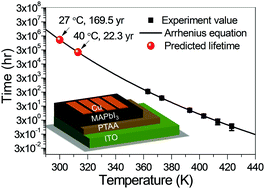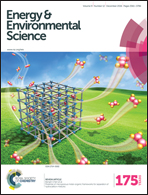Is Cu a stable electrode material in hybrid perovskite solar cells for a 30-year lifetime?†
Abstract
One grand challenge for long-lived perovskite solar cells is that the common electrode materials in solar cells, such as silver and aluminum or even gold, strongly react with hybrid perovskites. Here we report the evaluation of the potential of copper (Cu) as the electrode material in perovskite solar cells for long-term stability. In encapsulated devices which limit exposure to oxygen and moisture, Cu in direct contact with CH3NH3PbI3 showed no reaction at laboratory time scales, and is predicted to be stable for almost 170 years at room temperature and over 22 years at the nominal operating cell temperature of 40 °C. No diffusion of Cu into CH3NH3PbI3 has been observed after thermal annealing for over 100 hours at 80 °C, nor does Cu cause charge trap states in direct contact with CH3NH3PbI3 after long-term thermal annealing or illumination. High performance devices with efficiency above 20% with a Cu electrode retain 98% of the initial efficiency after 816 hours storage in an ambient environment without encapsulation. The results indicate Cu is a promising low-cost electrode material for perovskite solar cells for long-term operation.


 Please wait while we load your content...
Please wait while we load your content...